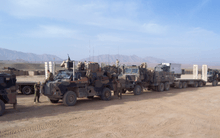Mentoring Task Force One
| Mentoring Task Force One | |
|---|---|
|
MTF-1 and Afghan soldiers patrol through a poppy field in April 2010 | |
| Active | 2009–10 |
| Country |
|
| Branch | Army |
| Type | Combined arms battle group |
| Size | 750 personnel |
| Part of | Combined Team Uruzgan |
| Garrison/HQ | Forward Operating Base Ripley, Tarin Kowt |
| Engagements | |
| Decorations | Meritorious Unit Citation |
Mentoring Task Force One (MTF-1) was a combined arms battle group formed by the Australian Army for deployment as part of Operation Slipper during the War in Afghanistan. Formed in 2009 from the 7th Brigade, the unit consisted of infantry, engineers, cavalry, artillery and logistic elements from 55 different units, but was predominately based on the 6th Battalion, Royal Australian Regiment (6 RAR). Based at Forward Operating Base Ripley outside of Tarin Kowt in Uruzgan Province as part of a multinational brigade known as Combined Team Uruzgan, MTF-1 was tasked with counter-insurgency operations in conjunction with United States, Dutch and other coalition forces, operating from a number of patrol bases in the Mirabad, Baluchi and Chora valleys. MTF-1 served in Afghanistan from January to October 2010.
History
Formed in 2009 for deployment as part of Operation Slipper during the War in Afghanistan, Mentoring Task Force One (MTF-1) was raised from the Brisbane-based 7th Brigade. The 750-strong combined arms battle group consisted of infantry, engineers, cavalry, artillery and logistic elements from 55 different units, but was primarily based on the 6th Battalion, Royal Australian Regiment (6 RAR).[1] Based at Forward Operating Base Ripley outside of Tarin Kowt in Uruzgan Province as part of a multinational brigade known as Combined Team Uruzgan, MTF-1 was tasked with counter-insurgency operations in conjunction United States, Dutch and other coalition forces, operating from a number of patrol bases in the Mirabad, Baluchi and Chora valleys.[2]
After completing mission-specific training in Australia, MTF-1 arrived in Afghanistan in January 2010. Initially commanded by Lieutenant Colonel Jason Blain, MTF-1 formally took over responsibility for the area of operations (AO) from Mentoring and Reconstruction Task Force Two in February.[3] Partnered with the 4th Brigade, 205th Corps of the Afghan National Army (ANA), MTF-1 operated throughout Uruzgan Province, with their AO extended west into the Tangi Valley following the Dutch withdrawal in August, while it also provided convoy escort and force protection in support of ANA resupply convoys into neighboring Kandahar Province.[1] Meanwhile, following a change in command Blain subsequently handed over to Lieutenant Colonel Mark Jennings on 21 June 2010.[4]

During its eight-month deployment MTF-1 conducted over 1,700 patrols involving more than 560 small-arms fire incidents, locating over 100 improvised explosive devices (IEDs) and more than 250 weapons and explosives caches. Involved in sustained operations, MTF-1 suffered nearly 40 battle casualties, including six killed in action, the majority from IEDs.[5] While attached to MTF-1, soldiers from Combat Team Delta (based on D Company, 6 RAR) took part in heavy fighting during the Battle of Derapet in Deh Rahwod on 24 August 2010, sustaining one killed. Corporal Daniel Keighran was later awarded the Victoria Cross for Australia for his role in the battle, the first member of the Royal Australian Regiment to receive such an award.[6]
MTF-1 handed over authority to Mentoring Task Force Two and returned to Australia in October and November 2010.[7] On 20 November, the task force marched through Brisbane's central business district along with other deployed units from the 7th Brigade, as the returning soldiers were officially welcomed home in the biggest such parade since the end of the Vietnam War.[7] MTF-1 was subsequently awarded the Meritorious Unit Citation in the 2011 Queen's Birthday Honours for "sustained outstanding service in warlike operations on Operation Slipper in Uruzgan Province, Afghanistan, between 20 January and 30 October 2010".[5] A number of other members of the task force were also decorated for their service with MTF-1, including both Blain and Jennings, who were each awarded the Distinguished Service Cross.[8]
Notes
- 1 2 "Combat Operations: Afghanistan". Australian and New Zealand Defender. Brisbane: Fullbore Magazines (71): 36. Spring 2010. ISSN 1322-039X.
- ↑ Dennis et al 2008, p. 9.
- ↑ "Changing of Guard for Australian Soldiers – Mission Continues". Department of Defence. 16 February 2010. Retrieved 11 July 2010.
- ↑ "Lieutenant Colonel Jason Blain Farewell". Department of Defence. 28 June 2010. Retrieved 11 July 2010.
- 1 2 "MUC – 1MTF: Full citation text" (PDF). Australian Government. 13 June 2011. Retrieved 20 August 2012.
- ↑ "Victoria Cross citation for Corporal Daniel Keighran". news.com.au. News Limited. 1 November 2012. Retrieved 1 November 2012.
- 1 2 "March in Brisbane to welcome soldiers who have served in Afghanistan, Iraq and East Timor". The Courier Mail. Brisbane: News Limited. 20 November 2010. Retrieved 20 November 2010.
- ↑ "Australia Day 2012 Honours List: Distinguished Service Cross (DSC)" (PDF). Australian Government. 26 January 2012. Retrieved 9 June 2013.
References
- Dennis, Peter; Grey, Jeffrey; Morris, Ewan; Prior, Robin; Bou, Jean (2008). The Oxford Companion to Australian Military History (Second ed.). Melbourne: Oxford University Press. ISBN 9780195517842.
Further reading
- Masters, Chris (2012). Uncommon Soldier: Brave, Compassionate and Tough, The Making of Australia's Modern Diggers. Crows Nest: Allen & Unwin. ISBN 1741759714.
